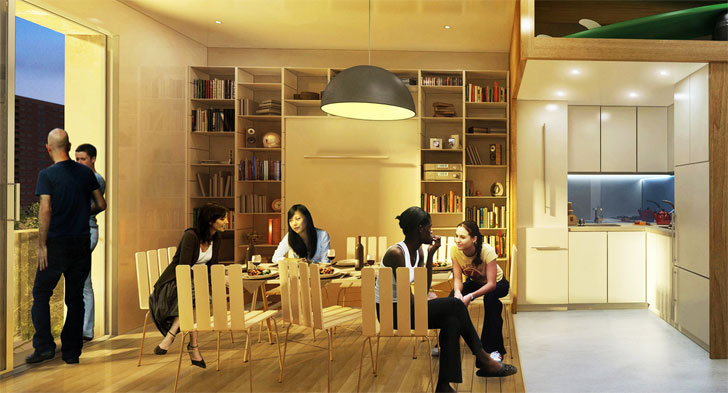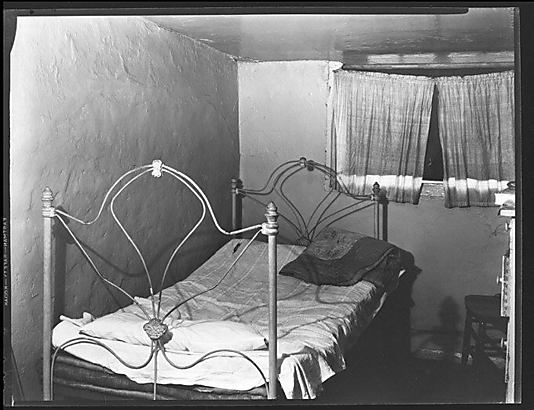Congruent with the world-wide need for urban housing, New York’s Mayor Bloomberg last year launched an RFP for adAPT NYC. Seems there will be an experimental building in Kips Bay, featuring apartments of 225 to 300 square feet. This is below what the current building code allows. Pre-fab, green, plug-in micro-apartments are now a real possibility. 225 square feet? Bigger than a room at the YMCA, but smaller than an East Village walk-up.
The Japanese who made urban history in the last century with their famous, now threatened, Tokyo pod-scraper are currently obsessed with filling every sliver of land, every alley, every oddly shaped parcel in Tokyo with some of the smallest and most glamorous single-family and/or single-occupant houses on earth. Commuting? Forget about it. Everyone hates it. See here my recent essay on small Japanese houses.
In New York we also have an urban implosion, but with a slightly different set of parameters. Soon we will need 1.8 million one-to-two person apartments.
“We have a shortfall now of 800,000, and it’s only going to get worse….”
said Bloomberg. “People from all over the world want to live in New York City.’
Everyone wants to be where the action is.
Or as Ann Sothern says in the 1939 Hotel for Women: “I saw the lights of Broadway all the way from Kansas City.” Or as I always say: I saw the paintings on MoMA’s walls all the way from Wall Township, New Jersey.
The Dorm Is the Norm
If you crave more than a computer-generated rendering or a micro-unit, “Making Room,” at the Museum of the City of New York showcases various proposals. Note that the centerpiece is not the adAPT winner. Instead the star attraction is a full-size, 325-square-foot, studio designed by the New York City-based firm Amie Gross Architects.
You can walk right in, sit on the unopened sofa-bed across from the flat-screen TV that folds down to become a table. I don’t know if you can really cook in the kitchenette or take a shower in the luxurious (to me) bathroom.
But why at half the size does it feel so much bigger than the 600 square foot East Village walk-ups now renting for $2,800? The Gross studio-apartment is on the square side, whereas East Village walk-ups are long and narrow, and were once called railroad flats. Big immigrant families lived in them. The loo was down the hall and if there was a bathtub, it was in the kitchen, had a lid, and doubled as a table. The secret? Everyone spent a lot of time on the stoop or the roof. How is that different from youths today putting in time at one Wi-Fi coffee-bar or another?
Micro-units are perfectly feasible in a world of take-out/eat-out scarfing and out-of-home frolicking. Some of the new micro-houses in Tokyo don’t even have kitchens. A built-in parking spot or room for a hobby like rock-climbing or cello- is more important than a kitchen or a single purpose living room.
The Gross at the Museum of the City of New York has shelves with a few books. And really not much stuff. No accumulated piles of art magazines , no paintings wrapped in garbage bags, no clothing too precious or to embarrassingly ragged and stained to recycle. No multiple sets of mid-century modern dinnerware. No walls of outdated tape- cassettes and cd’s. No flea market treasures. No memorabilia. No film cans, film stills. No drawing pads, no easels. No filing cabinets stuffed with manuscripts and mimeographed poetry magazines.
Here’s the secret to our brave new future:
We have to become Japanese. We must find cubbyholes under staircases; we must be cunning and neat; we must be on constant guard against clutter. The trend in Tokyo now is to digitalize all your books and thus be able to eliminate cumbersome bookcases and shelves. If there is a bed that is not a sofa-bed or a Murphy bed it must be on top of drawers.
If we live alone, as 46% of New Yorkers (young and old) now do, and do not envision guests, we could be satisfied with one chair. Our computer desk can be our kitchen table or the kitchen table/desk can slide out of the cabinet beneath the kitchen sink. See here for inspiration: Small Spaces by Azby Brown, Kodansha.
Do we really need a full set of dishes? Do we need dishes at all if we subsist on take-out? Clothes? Nerdy NYU guys in the East Village live in droopy rayon basketball shorts, flips, and T- shirts. All year round. That’s all they need to wear to run downstairs for a cappuccino, or a $15 Luke’s lobster roll or a $10 porchetta sandwich.
And, oh, yes, headroom counts, as does a view, any view. And freedom. Space is psychological. The average living space per person in India may be 50 square feet, which is the minimum space allowed for a U.S. prison cell, but at least you can come and go as you please. The average space per person in the U.S. may be 600 square feet, but if it is in suburbia, is it any better than a prison cell?
The Plots Thicken
Every time I take the Long Island Railroad through Queens, I look out through the train window and envision neo-modern Japanese houses wedged into backyards now sporting little else but dilapidated garages used for storing outdated VCRs, stuffed pandas and broken bicycle wheels. I see a carefully wrapped and winterized fig tree or two. Alas, they too will have to be sacrificed. I see the flagpole plots: narrow driveways leading to storage units and tin gazebos. And odd triangular bits of land. I imagine all-white houses with skylights and wonderful indoor gardens.
Although it is harder than ever to cross the Hudson River, the East River is no longer the river Styx.
But are there no unused spaces in Manhattan? I would plant houses on the Park Avenue meridian instead of tulips.
I would fill-in alleys and byways.
— Extra Place. Between The Bowery and 2nd Avenue off of First Street.
— Hall Place/Taras Shevchenko Place on 7th Street between Bowery and 2nd Ave. Does
the Ukrainian Museum really need an entrance on Taras Schevchenko Place. Why
not around the corner on 6th?
— Jersey Street between Crosby and Lafayette, South of Houston/ North of Prince.
— Freeman Alley between Bowery and Chrystie, running north off Rivington.
— Florence Place (Chinatown)
— Collister Street and Trimble Place (Tribeca)
— Charles Lane and Downing Street (Greenwich Village)
— Broadway Alley (Between Third and Lex/ between 27th and 26th)
And don’t forget those tempting donut holes at the center of most blocks. What do we need them for? Clotheslines? Alley-cat courtship fences? Pigeon poop pile-ups? Wet mattress storage? Stinky ailanthus trees?
But, wait a minute. Whatever happened to rooming houses and residency hotels? Before we start building mini-apartments on a large scale or indulging in Borough and alley in-fill, perhaps the Mayor’s Office should look at these for inspiration…..
Like Father, Like Son, or Yes, We Have No Pianos
In regards to residency hotels, do not think of S.R.O. hotels but of the sainted residents of the legendary Chelsea Hotel, ranging from Viva and Brigid Berlin to Virgil Thomson. Both Louise Brooks and Veronica Lake ended up at the Martha Washington Hotel for Women. But the less said about that the better. Or that I once temped at a mid-Manhattan hotel where the only topic in the office was how to get rid of the perpetually soused Ana May Wong.
I was born in New York City , but grew up mostly in Jersey. After escaping Montclair State Teachers College, I headed straight for home, my real home: Mannahatta.
Like many immigrants before me, I lived in furnished rooms. The last and best was on W. 12th Street, a few doors down from the New School. All the rooms had sinks, but there was a shared shower and two shared toilets on each floor. Cooking was forbidden. The end-table/desk sported my clandestine hot-plate for boiling water for instant coffee and occasional meals of what was called Rooming House Stew or, worse, Fairy Pudding — macaroni, canned tuna, and cream-of-mushroom Campbell’s soup. Don’t even think about trying it. You could also add potato chips for crunch.
The other tenants were poets, book store clerks, novelists and an artist who made a living with paintings of enormously endowed naked-men. And there was also the mistress of a Cuban existentialist.
My father had lived in a rooming house in his youth too. There was one feature I envied Although he said he was tortured by the constant repetition of their song “Lullaby of Broadway,” his downstairs neighbors were the songwriters Harry Warren and Al Dubin.
Come on along and listen to
The lullaby of Broadway.
The hip hooray and bally hoo,
The lullaby of Broadway.
The rumble of the subway train,
The rattle of the taxis.
The daffy-dills who entertain
At Angelo’s and Maxie’s.
When a Broadway baby says “Good night,”
It’s early in the morning.
Manhattan babies don’t sleep tight until the dawn:
Good night, baby,
Good night, milkman’s on his way.
Sleep tight, baby,
Sleep tight, let’s call it a day,
Listen to the lullaby of old Broadway.
Was there really a rooming house that allowed a piano?
John Perreault is on Facebook and Twitter. Main John Perreault website. John Perreault’s art. The Artopia Project also includes: artopianews ; artopiatecture ; thehousedetective ; /johnperreault.tumblr. AND pinterest.com/johnperreault1/





